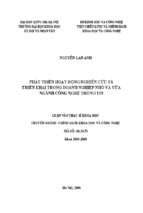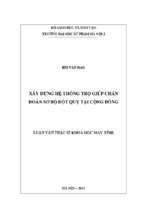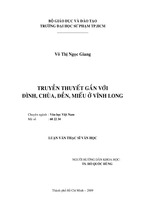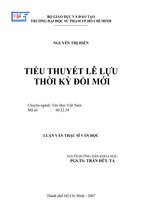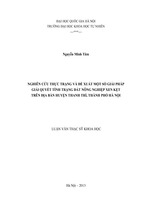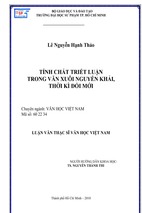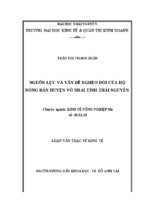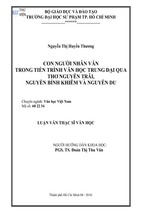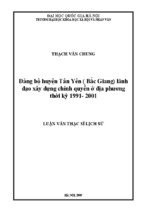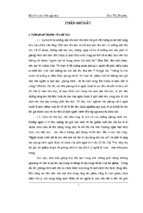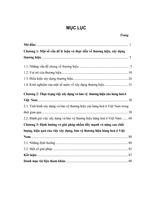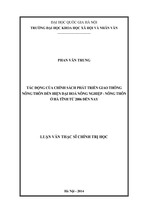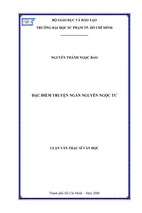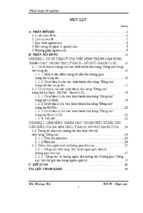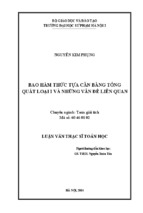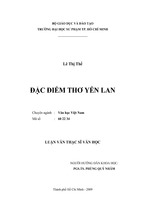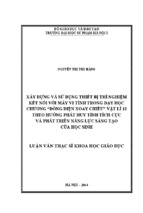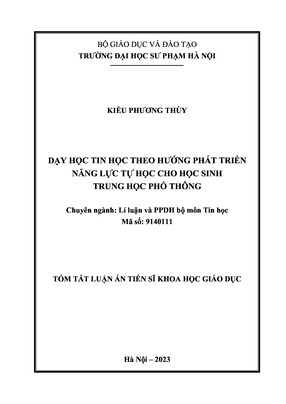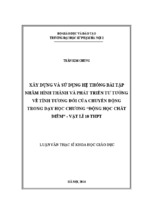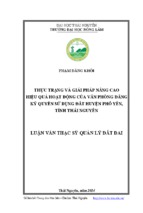VIETNAM NATIONAL UNIVERSITY, HANOI
UNIVERSITY OF LANGUAGES AND INTERNATIONAL STUDIES
FACULTY OF POST-GRADUATE STUDIES
**********************
N
O
T
N
AN EVALUATION OF VOCABULARY USED IN THE TEXTBOOK
“T ẾN AN 12” PUBL S ED BY V ETNAM EDUCATION
PUBLISHER IN 2008
ánh giá từ vựng trong sách giáo khoa “T ẾN AN 12” được xuất bản
bởi Nhà xuất bản Giáo dục Việt Nam năm 2008
M. A. MINOR PROGRAMME THESIS
Field: English Teaching Methodology
Code: 60140111
HANOI - 2017
VIETNAM NATIONAL UNIVERSITY, HANOI
UNIVERSITY OF LANGUAGES AND INTERNATIONAL STUDIES
FACULTY OF POST-GRADUATE STUDIES
**********************
N
O
T
N
AN EVALUATION OF VOCABULARY USED IN THE TEXTBOOK
“T ẾN AN 12” PUBL S ED BY V ETNAM EDUCAT ON
PUBLISHER IN 2008
ánh giá từ vựng trong sách giáo khoa “T ẾN AN 12” được xuất bản
bởi Nhà xuất bản Giáo dục Việt Nam năm 2008
M. A. MINOR PROGRAMME THESIS
Field: English Teaching Methodology
Code: 60140111
Supervisor: Dr. Ngu n Th Ng c Qu nh
HANOI - 2017
DECLARATION
I certify that this thesis entitled: “
“
in 2008. ,
which is submitted in partial fulfilment of M. A. Degree at Faculty of Post Graduate
Studies, University of Languages and International Studies, Vietnam National
University, Hanoi, is the result of my own work. The material in this thesis, wholly or
in part, has not been submitted for a degree to any other universities or institutions.
Hanoi, 2017
Signature
ng Ho i Th
i
ng
ACKNOWLEDGEMENT
First of all, I would like to express my sincere gratitude to Ms. Nguyen Thi
Ngoc Quynh. I would never have finished my dissertation without her useful and
insightful comments and advice. I would also like to give thanks to my teachers for
their precious sharing of experiences, knowledge, and resource materials with me
during my study. Last but not least, I wish to thank students and teachers participating
in my study, my colleagues, and study mates for their help and support throughout my
master’s degree course.
ii
ABSTRACT
The purpose of this study was to evaluate the voca ulary in the text ook TI NG
ANH 12 pu lished in 2008 in terms of the selection of voca ulary, the presentation,
and the vocabulary practice. The study investigated aspects of word knowledge, and
vocabulary learning strategies, and types of vocabulary activities underlying
vocabulary activities. A total of 180 randomly selected grade - twelve students and
five English teachers in an upper-secondary school in Bac Ninh province were
involved. The data were collected through textbook analysis with the help of Range
program by Nation (2002), questionnaires and interview. Then, the information
obtained from these sources were analysed quantitatively and qualitatively and
evaluated using a checklist. The data analysis tools used for the study are SPSS 20,
and Excel. The study consists of two main parts with the selection of vocabulary, the
designs of the explicit vocabulary activities with reference to vocabulary learning
strategies, and aspects of word knowledge, and types. The results showed that the
textbook has low pedagogical value and insufficient lexical input for learners in terms
of vocabulary selection. The results also showed that there is a gap between what is
pedagogically desirable about vocabulary learning strategies and what is actually
included in the textbook. The textbook hardly reflects all aspects of knowing a word in
its vocabulary tasks and lack of diversity in designing explicit vocabulary activities.
iii
TABLE OF CONTENTS
DECLARATION ..................................................................................................................................... i
ABSTRACT ........................................................................................................................................... iii
TABLE OF CONTENTS…………………………………………………………………………...….iv
LIST OF TABLES ................................................................................................................................. vi
LIST OF FIGURES............................................................................................................................... vii
CHAPTER 1: INTRODUCTION ........................................................................................................... 1
1.1. Rationale ...................................................................................................................................... 1
1.2. Scope of the study ........................................................................................................................ 2
1.3. The objective of the study ............................................................................................................ 3
1.4. Research questions ....................................................................................................................... 3
1.5. Significance of the study .............................................................................................................. 3
1.6. Organization of the dissertation ................................................................................................... 4
CHAPTER II: LITERATURE REVIEW AND THEORETICAL FRAMEWORK ............................... 5
2.1. Vocabulary learning and practice ................................................................................................. 5
2.1.1. Definitions of vocabulary ...................................................................................................... 5
2.1.2. Vocabulary learning and practice .......................................................................................... 6
2.2. Evaluation and Textbook evaluation ............................................................................................ 8
2.3. Evaluating vocabulary in a textbook using a checklist .............................................................. 10
2. 4. Vocabulary selection criteria ..................................................................................................... 14
2.5. Aspects of word knowledge ....................................................................................................... 17
2.6. Vocabulary learning strategies ................................................................................................... 19
2.7. Previous studies on evaluating vocabulary in the textbooks ...................................................... 20
CHAPTER 3: METHODOLOGY ........................................................................................................ 26
3.1. Methodological approach ........................................................................................................... 26
3.2. Research procedure .................................................................................................................... 26
3.3. Study population ........................................................................................................................ 27
3.4. The general description of the text ook TI NG ANH 12 ...................................................... 29
3. 5. Research instruments................................................................................................................. 31
3.5.1. Textbook analysis ................................................................................................................ 31
3.5.2. Survey questionnaire ........................................................................................................... 32
3.5.3. Interview.............................................................................................................................. 33
3.6. Data collection evaluative checklist ........................................................................................... 34
3.7. Data analysis tools...................................................................................................................... 34
CHAPTER 4: FINDINGS AND DISCUSSIONS................................................................................. 36
4.1. Research question 1: How are the target vocabulary items in the textbook under study selected?
........................................................................................................................................................... 36
4.1.1. Results from textbook analysis............................................................................................ 36
4.1.2. Results from survey questionnaires..................................................................................... 42
4.1.3. Results from interviews ....................................................................................................... 44
4.2. Research question 2: How is vocabulary presented and practised in relation to aspects of word
knowledge, vocabulary learning strategies, and types of vocabulary activities? .............................. 46
iv
4.2.1. Results from textbook analysis............................................................................................ 46
4.2.2. Results from survey questionnaires..................................................................................... 50
4.2.3. Results from interviews ....................................................................................................... 50
CHAPTER 5: CONCLUSION .............................................................................................................. 52
5.1. Summary of the major findings of the study .............................................................................. 52
5.2. Pedagogical implications............................................................................................................ 54
5.3. Limitations of the study and suggestions for further study ........................................................ 54
5.4. Concluding remarks ................................................................................................................... 55
REFERENCES ...................................................................................................................................... 56
APPENDICES.......................................................................................................................................... I
v
LIST OF TABLES
Table 1: Vocabulary size (Schmitt, 2000)……………………………………….…....15
Table 2: Aspects of word knowledge (Nation, 2001, p. 27)……………….………....18
Ta le 3: Research population’s information……………………………….…………27
Table 4: Groups of learners……………………………………………………….......28
Table 5: Information about teachers participating in the study……………….……....29
Table 6: Number of types and word families in the first three BNC word frequency
lists…………………………………………………………………………………….32
Table 7: Frequency of words in the whole book……………………………………...37
Table 8: The distribution of frequency words in the textbook……………………......39
Table 9: Range of key vocabulary items in the textbook under study……………......39
vi
LIST OF FIGURES
Figure 1: Types and tokens in the textbook……………………………………….38
Figure 2: Key vocabulary items in the textbook………………………………......40
Figure 3: Word grouping in the textbook…………………………………………41
Figure 4: Number of explicit vocabulary exercises………………………………42
Figure 5: Aspects of knowledge in explicit vocabulary activities………………..47
Figure 6: Vocabulary learning strategies in explicit vocabulary activities…….....48
Figure 7 (a): Types of vocabulary activities……………………………………....49
Figure 7 (b): Types of vocabulary activities………………………………………49
vii
CHAPTER 1: INTRODUCTION
1.1. Rationale
In English language teaching and learning in general, vocabulary plays a very
important role. Norbert Schmitt (2000, p. 19), stated that one of the key elements in
learning a foreign language is mastering L2 vocabulary. Wilkins (1972, pp. 111-112)
also wrote that …while without grammar very little can
e conveyed, without
vocabulary nothing can e conveyed . In fact, the more students learn, the more
complex they find their learning. Students do not only learn a single word, but at
advanced levels, they have to learn other components of the words including
antonyms, synonyms, allophones, collocation, semantic, and pragmatics. A rich
vocabulary makes the skills of listening, speaking, reading, and writing easier to
perform, (Nation, 1994, p. 8). Likewise, Richards and Rodgers (2002), appreciated the
role of vocabulary teaching and learning in comparison to grammar. Vocabulary
difficulty has been found to be one of the best predictors of text difficulty (Chall,
1958), cited in Steven A. Stahl and Michael C. Jacobson (1986, p. 309). Teaching
vocabulary will not guarantee success in reading, just as learning to read words will
not guarantee success in reading. However, lacking either adequate word identification
skills or adequate voca ulary will ensure failure (Biemiller, 2005). A wide number of
people around the world today use English as a second or foreign language. In learning
a language, vocabulary knowledge is viewed as an important factor.
Textbook plays a role as the skeleton for the whole learning and teaching
process. Sheldon (1988, p. 237), Course ooks are perceived y many to e the route
map for any ELT program, laying bare its shape, structure, and destination, with
progress, program, and even teacher quality being assessed by learners in terms of
sequential , unit-by-unit coverage . Thorn ury (2002) sees text ooks as sources of
words. He claims that vocabulary input is realized in the actual content of books by
means of segregated activities, integrated text-based activities, grammar explanations
and task instructions. In addition, textbooks are commodities, political objects, and
cultural representations and, therefore, are the site and result of struggles and
compromise in order to determine how and by whom they will be produced, how and
by whom their contents will be selected, how and to whom they will be distributed,
and how teachers and students will make use of them.
1
Evaluation can reveal the weaknesses and strengths of certain textbooks and
seek feasible supplementary materials or teaching techniques to overcome the
demerits. Evaluating vocabulary in its suitability will help teachers adapt their teaching
methods better. It is the teacher’s duty to understand why and what the vocabulary is
selected in the textbooks.
Therefore, I would like to explore further about the appropriateness of the
vocabulary presented in the text ook TI NG ANH 12 that is still in use in the
majority of upper-secondary schools in English teaching and learning context in
Vietnam in general and in an upper-secondary school in Bac Ninh province in
particular. Then, I can suggest some possible adaptations in teaching vocabulary for
larger groups of students and recommend better teaching techniques for teachers. The
study is also desired for suggesting a theoretical framework for further evaluation of
vocabulary in other textbooks.
1.2. Scope of the study
The study was limited in receptive vocabulary in the text ook TI NG ANH
12 , which was pu lished in 2008
y Vietnam national pu lisher of education,
Ministry of Education and Training. The formal presentation of vocabulary or explicit
presentation of vocabulary in reading, speaking, writing, listening sections and the
section of language focus, then incidental or indirect attention to vocabulary in some
sections of the textbook is beyond the scope of the study. McCarthy (1990, p. 67)
suggests that multi-word units should also be included in the high-frequency word
lists, little research has been done on the frequency of these items and how many of
them are needed for learners. Therefore, the frequency and range of multi-unit words
including phrasal verbs and idioms will be excluded in this study. Instead, those kinds
of words will be classified in the demonstration of vocabulary organization in the
study.
The research was restricted to only 180 students and 5 teachers in an uppersecondary school that could be representative for those who were using the textbook
under study. The primary focus was exclusive on grade 12th when students were going
to be school-leavers and finished their compulsory education in which English is an
important subject.
2
Finally, the data collected was gathered only from questionnaire, interview and
textbook analysis with the hope that it could have been richer with the help of more
data collection instruments.
1.3. The objective of the study
Due to the fact that textbooks are used directly as instructional materials and the
main tools in the teaching and learning process, this study is aimed at evaluating the
textbook to see if it can effectively teach vocabulary and equip students with essential
vocabulary learning strategies and provide students with essential word knowledge.
The study will review theories and researches concerning the selection of the
vocabulary used in the textbook, aspects of word knowledge, vocabulary learning
strategies and types of vocabulary activities. The ultimate goal of the study is to
suggest solutions or adaptations for teachers and textbook designers in relevance to
improving the quality of vocabulary selection, presentation and practice.
1.4. Research questions
Vocabulary can be studied from the perspective of breadth of knowledge which
is concerned with how much vocabulary a learner needs and depth of knowledge
which is concerned with the quality of the learners’ voca ulary knowledge. From
these two dimensions, the study focuses on answering two research questions:
1, How are the target vocabulary items in the textbook under study selected?
2, How is vocabulary presented and practised in relation to aspects of word
knowledge, vocabulary learning strategies, and types of vocabulary activities?
1.5. Significance of the study
The study can be significant in a number of ways. First of all, previous studies
have put much focus on textbook or material evaluation in all aspects without specific
emphasis on a single or particular item as vocabulary. Therefore, my research will go
in more details of material evaluation, particularly vocabulary. Then, the study can
propose suggestions for teachers to adapt more effectively the textbook so as to
improve English vocabulary learning for students. In addition, there have been
numerous studies on materials evaluation and vocabulary difficulty, but this study will
contri ute to a deeper research y investigating oth students and teachers’ opinions
3
on the vocabulary in the target textbook. In particular, triangulation in research is very
important and this approach offers a new way to evaluate the suitability of the
vocabulary in a particular textbook in a particular teaching and learning context.
…textbook evaluation is a science involving human values (Roberts, 1996). Then,
the research also provides data about teachers and learners working with the
voca ulary in the text ook, seeing how difficult they meet in developing students’
communicative competence as set out at the eginning part of the teachers’ ook
through questionnaires and interviews. Finally, the study is desired to suggest a
systematic evaluative checklist for vocabulary evaluation for other further studies.
1.6. Organization of the dissertation
The dissertation is organized into five chapters. Chapter 1 introduces the
rationale, the objective, the scope, and research questions of the study. Chapter 2
consists of a review of the relevant literature, which forms the basis for analyzing the
textbook. First, it provides a brief description of the textbook under study and then
looks at the definition of vocabulary, theories about vocabulary learning and practice.
Then, it provides different views on vocabulary selection criteria, evaluative checklist.
It also introduces theories on aspects of word knowledge and vocabulary learning
strategies. Chapter 3 introduces the methodology used in the study. Chapter 4 presents
the findings and discusses the results in relation to the guidelines in literature. Chapter
5 concludes on the study, discusses the limitations of the study. It also suggests some
adaptations as well as some advice for further study.
4
CHAPTER II: LITERATURE REVIEW AND THEORETICAL FRAMEWORK
2.1. Vocabulary learning and practice
2.1.1. Definitions of vocabulary
There are different definitions of vocabulary. Vocabulary refers to words that a
reader recognizes in
print
and
learning meanings of new words
– Beck,
McKeown, Kucan (2008, p. 1). Vocabulary is defined as the knowledge of words and
word meanings. More specifically, we use vocabulary to refer to the kind of words that
students must know to read increasingly demanding text with comprehension (Kamil
& Hiebert, 2005). Vocabulary can be defined as the words of a language, including
single items and phrases or chunks of several words which convey a particular
meaning, the way the individual words do (https://goo.gl/Uhb23r ). Vocabulary can be
defined as words we must know to communicate effectively; words in speaking
(expressive vocabulary) and words in listening (receptive voca ulary) ( Neuman &
Dwyer, 2009, p. 385). Horn y (1995) defines voca ulary as the total num er of
words in a language; voca ulary is a list of words with their meanings . Ur (1998)
states that vocabulary can be defined, roughly, as the words we teach in a foreign
language.
There are two types of vocabulary: receptive and productive vocabulary (Hatch
& Brown, 1995). Receptive vocabulary is words that learners recognize and
understand when they are used in context, but which they cannot produce. It is
vocabulary that learners recognize when they see or meet in reading text but do not use
it in speaking and writing (Stuart Webb, 2008). Another kind is productive vocabulary
which is the words that the learners understand and can pronounce correctly and use
constructively in speaking and writing. It involves what is needed for receptive
vocabulary and the ability to speak or write at the appropriate time. Productive
vocabulary can be addressed as an active process as the learners can produce the words
to express their thoughts (Stuart Webb, 2005). Nation (2001, pp. 24-25) claims that
receptive voca ulary size involves perceiving the form of a word while listening or
reading and retrieving its meaning . In this sense, receptive use dominates normal
language learning (Nation, 2001, p. 29.). On the other hand, productive voca ulary
5
use involves wanting to express a meaning through speaking or writing and producing
the appropriate spoken or written word form .
All words belong to categories called word classes (or parts of speech) English
has four major word classes: nouns, verbs, adjectives, and adverbs (Cambridge
Dictionary). Other word classes include prepositions, pronouns, determiners,
conjunctions, and interjections. In grouping vocabulary items semantically,
collocations, fixed expressions, and idioms are also considered.
2.1.2. Vocabulary learning and practice
It is necessary to distinguish explicit learning and implicit learning. Tomlinson
(1998, p. 4) wrote that language learning can e explicit (i.e. the learners are aware of
when and what they are learning) or it can be implicit (i.e. the learners are not aware of
when and what they are learning). Direct teaching of vocabulary relates to the
grammar translation method and incidental (the communicative approach). Schmitt
(2000, p. 116) suggested that two main processes of voca ulary acquisition: explicit
learning through the focused study of words and incidental learning through exposure
when one’s attention is focused on the use of language, rather than the learning itself .
Nation (2001, p. 384) mentioned that vocabulary learning does not benefit from being
planned, but can be determined by the occurrence of words in texts, tasks, and themes.
The purpose of vocabulary learning should include both remembering words and the
ability to use them automatically in a wide range of language contexts when the need
arises (McCarthy, 1984).
Vocabulary learning is effective when it entails active engagement that goes
beyond definitional knowledge. Stahl and Kapinus (2001) stated that when children
‘know’ a word, they not only know the word’s definition and its logical relationship
with other words, they also know how the word functions in different contexts.
Tickoo (2003) believed that extensive reading, contextualized presentation of words,
and inference can lead to more effective vocabulary learning than procedures
predominantly relying on dictionary usage and translation.
Word frequency is a factor that affects vocabulary learning. The frequency of a
word indicates its occurrences across a wide range of texts. Frequency in vocabulary
learning matters for two reasons. Firstly, most often used lexical items should be
6
learned first because they contribute to communicative competence more significantly.
Secondly, frequency of occurrence creates chances for repetitive practice, which is one
of the essential conditions for vocabulary consolidation. Lotto and DeGroot’s (1998)
study concluded that high-frequency words are easier to learn and retrieve than lowfrequency words. However, the proficiency level of learners will determine the
number of word exposures. Liu (2002) discovered that the optimal pick-up exposure
frequency range for English foreign language senior high school students with
different English proficiency fell at the range from six to twelve exposures.
Together with frequency, repetition and multiple exposures to vocabulary items
are important. Stahl (2005) cautioned against mere repetition or drill of the word,
emphasizing that vocabulary instruction should provide students with opportunities to
encounter words repeatedly and in a variety of contexts. Memory, review, and
repetition take a crucial role in the complex process of learning a lexical item. Nation
(2001, pp. 76-77) maintained that repetition brings quantitative and qualitative benefits
to voca ulary learning. He said that repetition is essential for voca ulary learning
because there is so much to know about each word that one meeting with it is not
sufficient to gain this information, and because vocabulary items must not only be
known, they must e known well so that they can e fluently accessed . Recycling is
synonymous to revision, repetition or consolidation of knowledge. A word may need
to be recycled three, four, five, or six times before it is learned adequately Cunningsworth, 1986, p. 25). Carter (1998, p. 193) proposed there are at least 6-7
repetitions in the state of rote-learning. At more advanced stages, exposure should
amount to 10-12 to ensure retention (Coady & Huckin, 1997, p. 225). Mitra
Hashemzadeh (2012) studied the effect of exercise types on EFL learners’ vocabulary
retention by utilizing action research within two weeks. The results from the test
showed that recognition exercises (fill-in-the-blank and matching) are more effective
than production exercises (paraphrasing and glossing). The author then included that
unknown words should be repeated in different exercises so as to be stored in longterm memory and retained effectively.
When it comes to vocabulary learning tasks in the textbook, Wallace (1982),
proposed different purposes of vocabulary tasks as follow:
7
- The teacher can look at them from the point of view of expanding his or her range of
techniques when involved in vocabulary teaching from a context or in a situation
- Tasks can be used to focus on some aspects of vocabulary learning
- Some aspects of vocabulary (but not all) can be developed in an autonomous or semiautonomous way, i.e. more or less independently of the teacher. Provided that the
student is able to correct his answers, vocabulary is one of those areas of language
learning where a well-motivated learner can make giant strides on his own is / he is
given the right kind of material to work on, and vocabulary development exercises can
have a role to play here.
- Some of the tasks can also be used as tests. Vocabulary exercises found in the
textbooks and courses are in fact tests. The purpose of a vocabulary exercise is to
develop the learner’s communication of the target language voca ulary, not simply to
find out whether she/ he knows particular item of vocabulary or not. However, a close
relationship exists between tests and exercises, since many exercises can be made into
tests and vice versa.
Coady and Huckin (1997, pp. 182-184) suggested that all vocabulary exercises
can be grouped into five categories: (1) Selective attention – the least demanding
exercise type- which implies noticing (e.g.
oldfacing), (2) Recognition which
involves partial knowledge (e.g. matching), (3) Manipulation which entails rearranging
in terms of morphology and grammar (e.g. using affixes to construct words, complete
table, (4) Interpretation which presupposes analysis of meaning and use in contexts
(e.g. multiple choice cloze exercises, completing sentences, (5) Production – the most
demanding exercise type-which means production in appropriate contexts (e.g. open
cloze exercises, finding a mistake).
2.2. Evaluation and Textbook evaluation
Evaluation plays a key role in education and it is important for the teacher since
it can provide valuable information for the future going of classroom practice, the
planning of courses and management of learning tasks by students. Evaluation aims to
discover whether what one is looking for is there , McGrath 2002, p. 32).
Evaluation is defined as a systematic appraisal of the value of materials in relation to
their o jectives and to the o jectives of the learners using them , Tomlinson (1998, p.
8
11). Evaluation refers to the fit of the text ook with the teaching context, i.e. learners,
teachers, school settings, and educational policies in the country.
Evaluation is the process of judging something’s quality, importance, or value.
According to Longman Dictionary of Contemporary English, (2001), evaluation is the
act of considering something to decide how useful or valuable it is. Rea-Dickins &
Germaine (1992, p.4) stated that evaluation is an intrinsic part of teaching and
learning. McGrath’s asic explanation of text ook evaluation concerns the discovery
of whether what you were looking for was there. When found, you then need to put a
value on your findings. Evaluation implies judgment-making which therefore also
means that evaluation is subjective. Although when evaluating, McGrath (2002, p. 22)
claimed that you might miss the unusual and the innovative.
Textbook evaluation has been an interesting topic to study because a textbook
or a course book plays an important role in teaching. According to (Ur, 1996, p. 184),
a textbook contains a teaching framework and syllabus, ready- made texts and tasks,
economy, convenience, guidance and autonomy. Identifying the strengths and
weaknesses in textbooks, optimum use can be made of strong points, and weaker
points can be adapted or substituted from other books as mentioned in Cunningsworth
(1995, p. 14). Materials and textbooks evaluation have emerged to add to criteria of
appropriateness to know to some extent which English textbook is more effectively
used.
The evaluation as a cyclical process is suggested by Ian McGrath (2002, p. 14);
this consists of pre-use evaluation, in-use evaluation and post-use evaluation. In this
study, post-use evaluation is carried out. Post use evaluation is carried out at the end of
the academic school year. According to Ellis (1998), it is aimed at examining in a
more comprehensive way the impact of using the textbook/ course book, assessing
how far the material motivates the students, or examining the application of
knowledge or skill to a different situation without any assistance. The areas can be
quantitatively measured including lexical repertoire (McGrath, 2002, p. 199). This
offers careful evaluation which can make the research more valid and reliable. In his
book, Grant (1987, p. 118), states that a good book should satisfy three conditions.
Firstly, it should suit the needs, interests and abilities of your students. Second, it
should suit you (The est ook in the world won’t work in your classroom if you have
9
good reasons for disliking it). Thirdly, the textbook must meet the needs of official
public teaching syllabus or examinations.
An evaluation can be made of how the materials match the target situation of
use and whether it is necessary to take action, i.e. modifying the materials,
supplementing or rejecting them. Therefore, the results of any materials evaluation
must necessarily be context-dependent - Laura & Schmitt (2017, p. 32). Evaluation
can highlight strengths and weaknesses in existing course books, thus providing the
basis for formulating new textbooks policies and developing new materials.
2.3. Evaluating vocabulary in a textbook using a checklist
In the first words, using checklist method or using a checklist for evaluating
vocabulary is appropriate with the current study. Ian McGrath (2002, pp. 26-27), lists
four benefits of using a checklist for in-depth evaluation.
1. It is systematic, ensuring that all elements that are deemed to be important
are considered.
2. It is cost-effective, permitting a good deal of information to be recorded in a
relatively short space of time.
3. The information is recorded in a convenient format, allowing for easy
comparison between competing sets of material.
4. It is explicit, and, provided the categories are well understood by all involved
in the evaluation, offers a common framework for decision-making.
Cunningsworth (1995) suggests six criteria in order to evaluate the lexical
presentations in ELT materials:
(1) Is vocabulary learning material included on its own right? If so, how prominent is
it? Is it central to the course or peripheral?
(2) How much vocabulary is taught? - Is there any principled basis for the selection of
vocabulary?
(3) Is there any distinction of between the active and passive vocabulary, and
classroom vocabulary?
(4) Is vocabulary presented in a structured, purposeful way?
10
(5) Are learners sensitized to the structures of the lexicon through vocabulary learning
exercises based on semantic relationships, formal relationships, collocations and
situation-based word groups?
(6) Does the material enable students to expand their own vocabularies independently
by helping them to develop their own learning strategies? (p.46)
Litz (2007) presents a teacher textbook evaluation form which includes four
items for vocabulary evaluation:
(1) The textbook includes a detailed overview of the vocabulary that will be taught in
each unit
(2) An adequate vocabulary list or glossary is included
(3) The vocabulary items are introduced in motivating and realistic contexts
(4) The progression of vocabulary items is appropriate
Miekley (2005) provides a textbook evaluation checklist:
(1) Are the new vocabulary words presented in a variety of ways?
(2) Are the new vocabulary words presented at an appropriate rate so that the text is
understandable and so that students are able to retain new vocabulary?
(3) Are the new vocabulary words repeated in subsequent lessons to reinforce their
meaning and use?
(4) Are students taught top-and-down techniques for learning new vocabulary words?
Grant (1987, pp. 119 - 120) presents the CATALYST model Test which provides
some questions that determine whether the textbooks being used are suitable for the
class or not. The eight letters in the word CATALYST represent the eight criteria by
which we can decide whether a textbook/material is suitable for our classroom
objectives and needs. Communicative? Is the text book communicative? This question
aims to find out whether the students after using this book will be able to use the
language to communicate. Aims? Does it fit in with the aims and objectives? These
may be laid down by educational authorities, or devised on our own. Teachable? Does
the course seem teachable? Does it seem reasonably easy to use, well organized, and
easy to find your way round? Available Adds-ons? Are there any useful adds-onsadditional materials such as teacher’s ooks, tapes, work ooks, etc.? Level? Does the
level seem out right? Your impression? What’s your overall impression of the course?
Student interest? Are the students likely to find the book interesting? Tried and tested?
11
- Xem thêm -


